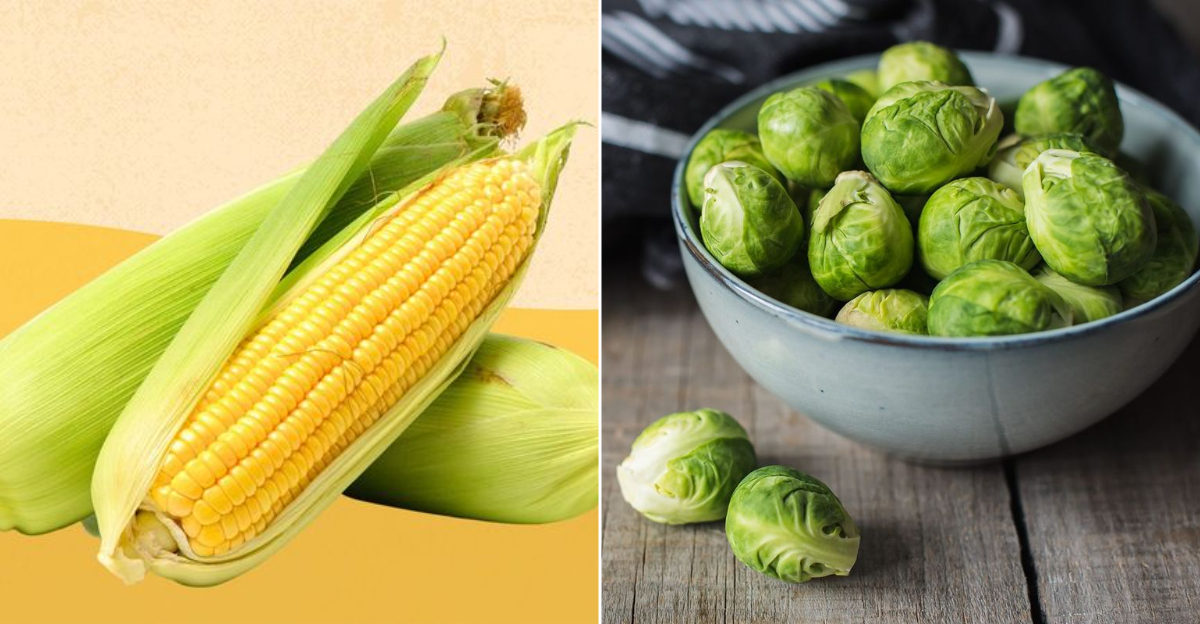8 Vegetables That Might Not Be As Healthy As You Thought & 8 That Are Smart Picks

Not all veggies deserve their health halos! While we’ve been taught to eat our vegetables since childhood, some popular options might not be as nutritious as their reputation suggests. Others come with unexpected downsides when prepared in certain ways or eaten in large amounts.
It is an ideal time to uncover which vegetables might be overrated and discover some nutritional superstars you should add to your plate instead.
1. Corn: More Starch Than Veggie
Yellow kernels might look innocent enough, but corn is technically a grain masquerading as a vegetable. With high starch content and natural sugars, it spikes blood sugar faster than many other veggies.
My family’s summer barbecues always feature buttery corn on the cob, but I’ve started limiting myself to half an ear.
The nutritional profile resembles bread more than broccoli, offering less fiber and vitamins than truly nutrient-dense vegetables.
2. Iceberg Lettuce: The Hydration Station
Crispy and refreshing, but nutritionally bankrupt! Iceberg lettuce is mostly water with minimal vitamins, minerals, or fiber. The pale color tells the story – darker greens pack significantly more nutrients.
Restaurant salads often feature this watery leaf because it’s cheap and has a long shelf life. While not harmful, iceberg merely takes up valuable real estate on your plate that could be filled with vegetables offering actual nutritional benefits.
3. Celery: The Crunchy Water Stick
Celery sticks might be dieters’ darlings, but they’re essentially crunchy water tubes. The myth about celery burning more calories to digest than it contains isn’t quite accurate – it just provides very few calories to begin with.
Growing up, my mom would stuff them with peanut butter, which I now realize was the only nutritional value in that snack! While celery offers some vitamin K and antioxidants, you’d need to eat mountains of it to get meaningful nutrition.
4. Potatoes: The Preparation Problem
Spuds themselves aren’t villains – they contain vitamin C, potassium, and fiber in their skins. The trouble begins with preparation: French fries, chips, and loaded baked potatoes transform this humble tuber into a calorie bomb.
White potatoes also rank high on the glycemic index, causing blood sugar spikes. The starchy nature of potatoes means they behave more like bread in your body than like other vegetables, potentially contributing to weight gain when consumed frequently.
5. Canned Vegetables: Sodium Soakers
Canned vegetables often swim in preservation baths of salt water, with some varieties containing nearly 40% of your daily sodium limit in just one serving.
The canning process also diminishes vitamin content, particularly water-soluble vitamins like C and B. I discovered this after tracking my sodium intake for a week – those three cans of green beans contributed more salt than my daily sandwich!
Choose low-sodium versions or rinse thoroughly to reduce salt content.
6. Vegetable Juice: Sugar Without the Fiber
Bottled vegetable juices seem virtuous but often harbor hidden sugars and salt. The juicing process strips away fiber, which normally slows sugar absorption and keeps you feeling full.
Without fiber, these drinks can spike blood sugar similarly to fruit juice. Many commercial brands add extra sodium as a preservative and flavor enhancer.
You’re better off eating whole vegetables to get the complete package of nutrients with their natural fiber intact.
7. Pickled Vegetables: Salt-Preserved Nutrition Losers
Tangy and addictive, pickled vegetables lose significant nutritional value during processing. The pickling liquid often contains excessive sodium and sometimes added sugars.
Heat-based pickling methods destroy heat-sensitive vitamins like C and B. While fermented pickles offer probiotic benefits, most commercial versions are simply vinegar-soaked, offering little probiotic advantage.
The high salt content makes them problematic for those monitoring blood pressure or water retention.
8. Conventional Bell Peppers: Pesticide Problems
Colorful bell peppers frequently appear on the “Dirty Dozen” list of pesticide-contaminated produce. Their thin skins offer little protection against agricultural chemicals, which can remain even after washing.
Conventional peppers are often harvested unripe and treated to appear mature, reducing their natural vitamin content. I noticed the difference when growing my own last summer – homegrown peppers had dramatically more flavor and sweetness!
9. Kale: The Nutrient Powerhouse
Hail to the king of greens! Kale delivers an impressive nutritional punch with more vitamin C than an orange and more calcium than milk per calorie. Its robust fiber content supports digestion while powerful antioxidants protect cells from damage.
The slightly bitter taste that some find challenging actually signals the presence of beneficial compounds. Massage raw kale with a bit of olive oil to soften both texture and flavor.
This versatile green works in smoothies, salads, soups, and even as crispy chips.
10. Sweet Potatoes: The Colorful Carb Upgrade
Orange-fleshed beauties outshine white potatoes nutritionally with beta-carotene that supports eye health and immune function. Their natural sweetness satisfies cravings while providing steady energy without dramatic blood sugar spikes.
One medium sweet potato delivers over 400% of your daily vitamin A needs! My weekend meal prep ritual now includes batch-roasting these tubers for quick weekday meals.
The fiber-rich skin contains additional nutrients, so scrub well and enjoy the whole package.
11. Broccoli: The Versatile Cruciferous Champion
This miniature tree-shaped vegetable contains sulforaphane, a compound with impressive cancer-fighting potential. Broccoli provides vitamins C and K, folate, and fiber in a low-calorie package that keeps you satisfied.
The entire plant is edible – florets, stems, and even leaves contain different nutrient profiles. For maximum nutrition, lightly steam rather than boiling.
I’ve converted many broccoli-haters with my roasted garlic version that brings out natural sweetness while maintaining nutritional integrity.
12. Spinach: The Iron-Rich Leaf
Popeye wasn’t wrong about this leafy powerhouse! Spinach delivers iron, magnesium, and vitamins A and K in abundance. Its mild flavor makes it incredibly versatile in everything from smoothies to pasta dishes.
The oxalates in raw spinach can reduce mineral absorption, so light cooking actually increases nutritional availability. I keep frozen spinach cubes ready for quick nutrition boosts in soups and sauces.
Unlike watery lettuce, spinach maintains volume and nutrition when cooked.
13. Red Cabbage: The Purple Protector
This vibrant vegetable contains anthocyanins – the same compounds that give blueberries their superfood status – at a fraction of the cost. The rich purple pigment signals powerful antioxidant properties that fight inflammation and cellular damage.
Cabbage’s impressive vitamin C content supports immune function and collagen production. After discovering cabbage keeps fresh for weeks in the refrigerator, it’s become my emergency vegetable when the crisper drawer looks bare!
Try it raw in slaws, fermented as sauerkraut, or quickly stir-fried.
14. Brussels Sprouts: The Redeemed Veggie
These miniature cabbages have overcome their bad reputation through modern cooking techniques that highlight their natural sweetness. Roasting transforms them into caramelized, nutty delights while preserving their impressive nutritional profile.
Rich in vitamins K and C, Brussels sprouts also provide unique compounds that support detoxification pathways in the liver.
My brother hated these as a kid but became a convert after trying my maple-balsamic roasted version at Christmas dinner! Their satisfying texture makes them surprisingly filling.
15. Garlic: The Medicinal Bulb
This potent bulb transcends mere seasoning status with impressive medicinal properties. Allicin, released when garlic is crushed or chopped, has natural antibacterial and antiviral properties that support immune function.
Regular consumption may help lower cholesterol and blood pressure while reducing risk of certain cancers. Allow crushed garlic to rest for 10 minutes before cooking to maximize allicin formation.
During last winter’s cold season, I increased my garlic intake and noticed fewer sniffles than usual!
16. Watercress: The Underrated Superfood
Peppery little leaves pack tremendous nutritional density, earning watercress top ranking in a CDC study of nutrient-dense foods. Regular consumption may reduce DNA damage linked to cancer development while supporting respiratory health.
Watercress contains more calcium than milk and more vitamin C than oranges per calorie. I discovered this gem while researching traditional British tea sandwiches and now add it to everything!
Its bright flavor enlivens salads, sandwiches, and soups with minimal calories.
